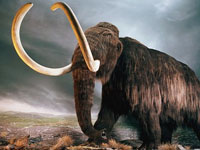
猛犸象又名长毛象,因全身长满用以御寒的长毛而著称,已于约1万年前灭绝。加拿大科学家成功再造猛犸象的血液,或许在未来可以让这一物种重现地球。
迁移之谜
猛犸象堪称最负盛名的史前哺乳动物,其生存的时代为冰河世纪。猛犸象与现存的非洲象和亚洲象是近亲,最早都在赤道附近的非洲地区活动。
大约120万年至200万年前,气候变化导致气温骤降。猛犸象遂向北半球高纬度迁移,在极地附近的冰原上觅食与生活。
猛犸象的迁移行为令人费解,因为低温会抑制象体内输送氧气的血红蛋白,导致它们无法在寒冷气候中生存。科学家由此猜测猛犸象的血红蛋白可能发生了变异。
加拿大马尼托巴大学研究人员通过对比猛犸象和现存非洲象、亚洲象的基因证实了这一猜测:猛犸象具有遗传适应能力,它们的血液基因发生了突变。即使在低温环境中,猛犸象的血红蛋白也能输送氧气。
再造血液
在科幻小说《侏罗纪公园》中,从几百万年前的琥珀中提取出的昆虫脱氧核糖核酸(DNA)可以再造恐龙。这或许给科学家带来了灵感。
马尼托巴大学研究人员在西伯利亚的冻土层中找到三具约四万年前的猛犸象“遗体”,从它们的骨骼中提取出血红蛋白DNA,按顺序排列好,再将其转录为核糖核酸(RNA)并放入大肠杆菌中培养。
最终,猛犸象的血红蛋白在大肠杆菌中获得“重生”。
相关研究成果刊登在最新一期《自然遗传学》杂志上。
英国《每日邮报》2日援引研究报告作者之一、马尼托巴大学教授凯文坎贝尔的话报道:“这种合成的血红蛋白取材于真实的猛犸象标本,与猛犸象活体体内的血红蛋白没有区别。”
有望复活
研究人员对再生血液进行检测,发现血红蛋白的排列顺序发生了三处明显改变,正是这种改变使猛犸象的血液变得“抗冻”。现存的大象并不具备这种能力。
这种改变也表现在其他一些生活在北极地区的物种身上,比如驯鹿和麝香牛。
科学家相信,借助这种遗传适应技术能够重建猛犸象身体的其他部分,使其复活。
这项研究已经持续7年,参与其中的英国约克大学教授米基霍夫赖特说:“这项研究是运用古老DNA再造灭绝物种的第一次探索,具有重要的进步意义和广泛的适用性。”
但是再造出血液蛋白质并不意味着能够重建动物的整个身体,因为DNA无法保存在化石中。《每日邮报》说,对于恐龙这类几百万年前就已经灭绝的物种而言,科学家也回天乏术。

Substitutions in woolly mammoth hemoglobin confer biochemical properties adaptive for cold tolerance
We have genetically retrieved, resurrected and performed detailed structure-function analyses on authentic woolly mammoth hemoglobin to reveal for the first time both the evolutionary origins and the structural underpinnings of a key adaptive physiochemical trait in an extinct species. Hemoglobin binds and carries O2; however, its ability to offload O2 to respiring cells is hampered at low temperatures, as heme deoxygenation is inherently endothermic (that is, hemoglobin-O2 affinity increases as temperature decreases). We identify amino acid substitutions with large phenotypic effect on the chimeric β/δ-globin subunit of mammoth hemoglobin that provide a unique solution to this problem and thereby minimize energetically costly heat loss. This biochemical specialization may have been involved in the exploitation of high-latitude environments by this African-derived elephantid lineage during the Pleistocene period. This powerful new approach to directly analyze the genetic and structural basis of physiological adaptations in an extinct species adds an important new dimension to the study of natural selection.







